Deletions:
Wald St?ck (Forest Piece)
The German "Waldst?ck" is a compound of "Wald" (="forest") and "St?ck" (="piece", but also "play", "dramatic performance"), describing a small wooded area.A nocturnal event. Two sets of photographs: one taken at night, as it happened, one the next day, going back to where it happened.
This selection of photographs accompanies the exhibition of Wald St?ck at the SMU MA Art & Design Show. 27.06 ? 03.07.2008.
A different selection than the one displayed in the exhibition, suggesting a different event?
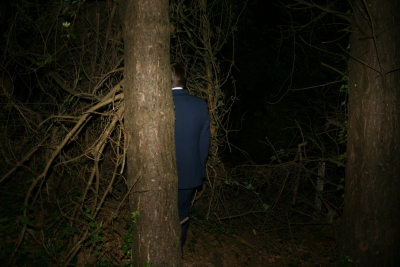
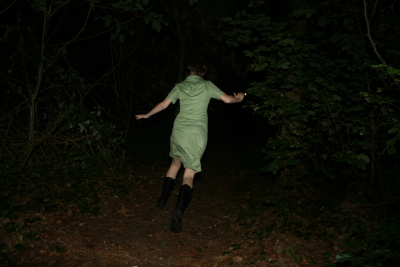
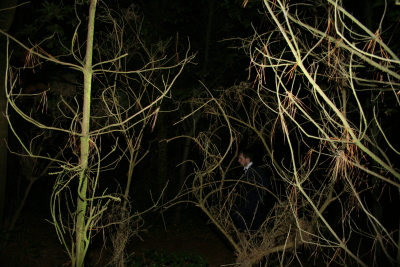
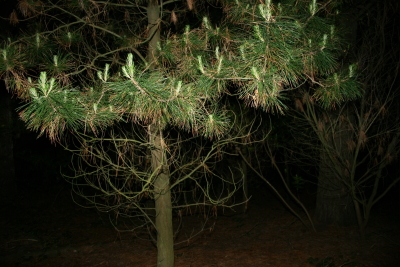
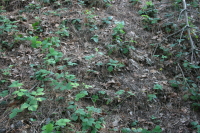
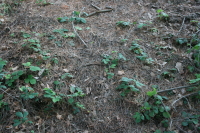
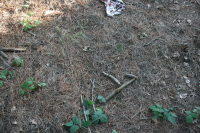

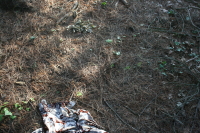
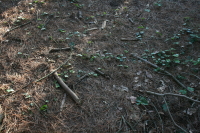
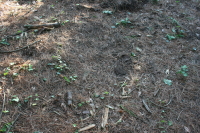
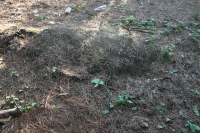
Waldst?ck
The German "Waldst?ck" is a compound of "Wald" (="forest") and "St?ck" (="piece", but also "play", "dramatic performance"), describing a small wooded area.Tracing a strange nocturnal event in what appears to be a forest, Waldst?ck explores the relation between photographic documentation and the event.




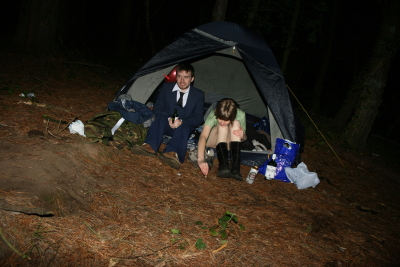
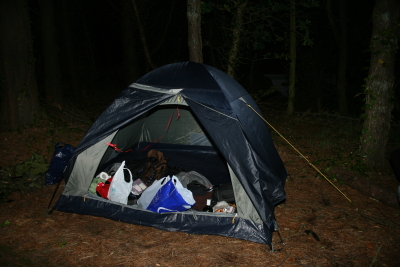
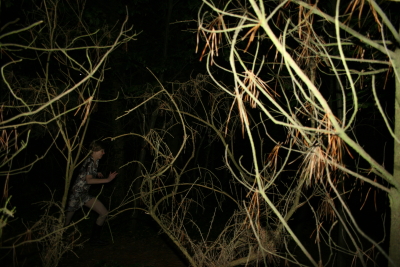
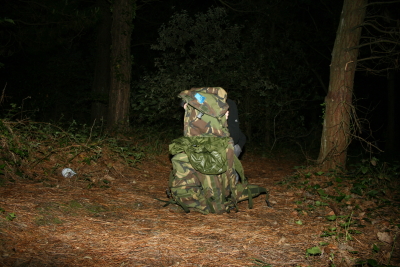
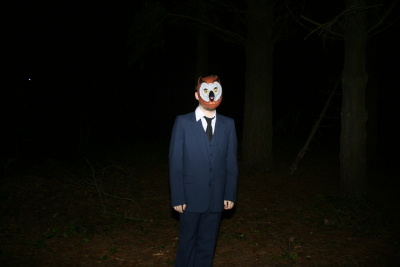
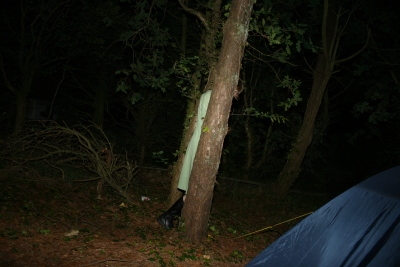
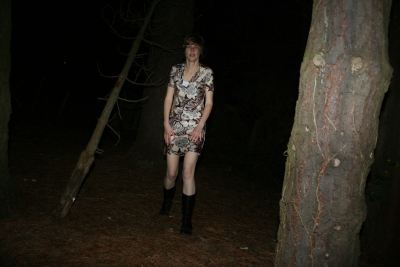
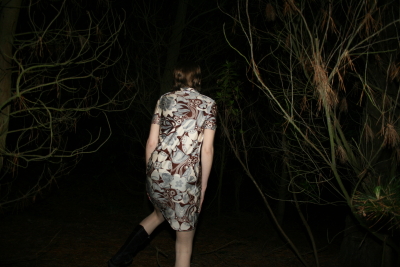
crime scene

flash
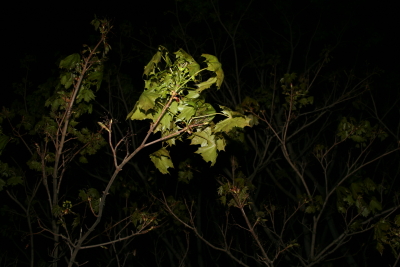
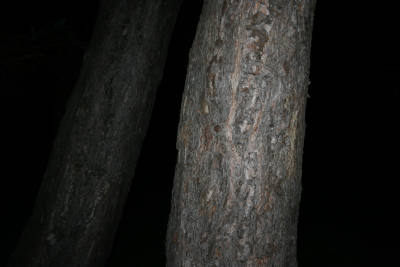
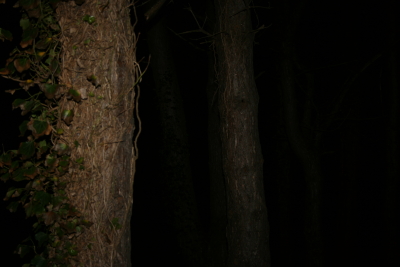
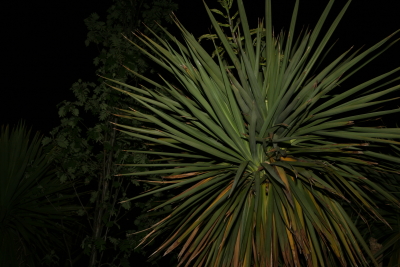
Christian Philipp M?ller
Green Border
Introduction
In 1993 the Swiss artist Christian Philipp M?ller followed an invitation by curator Peter Weibel
to exhibit in the Austrian Pavilion at the Venice Biennale alongside American artist Andrea
Fraser and Austrian artist Gerwald Rockenschaub. M?ller?s contribution Green Border consisted
of several parts, most importantly of eight illegal border crossings he undertook from Austria to
its neighbouring countries, and of an installation in the Pavilion.
Green Border is not only discussed in the context of Land Art (Kastner 1998: 133), but also
plays a prominent role in current debates on site-specificity (Kwon 2004, Meyer 2000a, Meyer
2000b).
However, how exactly does Green Border articulate a relationship to a specific site? And
furthermore, where is this site located: at eight different borders, at the Austrian Pavilion in
Venice? By looking at the example of Green Border this essay will investigate current
developments and debates within the context of site-specific art. Before turning to a more
detailed analysis of M?ller?s work a short historical overview of the term and practice of site-
specific art seems helpful to outline the basic premises, but also the changing meanings of site-
specificity up until today.
Site-specific Art
In the introduction to the book One Place after Another. Site-Specific Art and Locational Identity
Miwon Kwon describes how the idea of site-specificity has become an almost commonplace
reference in contemporary art practice:
[...] the term 'site-specific' has been uncritically adopted as another genre category by
mainstream art institutions and discourses. The term is indeed conspicuous in a diverse
range of catalogue essays, press releases, grant applications, magazine reviews, and artist
statements today; it is applied rather indiscriminately to art works, museum exhibitions,
public art projects, city arts festivals, architectural installations; and it is embraced as an
automatic signifier of 'criticality' or 'progressivity' by artists, architects, dealers, curators,
critics, arts administrators, and funding organizations.
(Kwon 2004: 1)
This frequent (and frequently vague) use of the term ?site-specific? in various art contexts in
order to describe a range of diverse artistic practices seems to call into question the idea of a
critical impulse which has accompanied site-specific art since it emerged in the 1960s and 70s
and, according to Kwon, with which it still is associated today. This initial critical impulse was
primarily focused against the modernist claim of the art work's autonomy. Artists working in the
contexts of Minimal Art, Institutional Critique, Land Art etc. started exploring the relationship
between the art work and its context: ?It is the recognition on the part of minimalist and
earthworks artists of the 1960s and 1970s that 'site' in and of itself is part of the experience of the
work of art.? (Suderburg 2000: 4). This exploration emphasized the interrelationship between art
work, spectator and space. In his famous essay Art and Objecthood Michael Fried denounced
exactly this quality of minimalist1 sculpture as ?theatrical?, thereby providing an adequate
description of how these art works (in contrast to modernist works which Fried favours) were
dependent on their context, on the act of viewing, on the respective situation:
Literalist sensibility is theatrical because, to begin with, it is concerned with the actual
circumstances in which the beholder encounters literalist work. [...] the experience of
literalist art is of an object in a situation ? one that, virtually by definition, includes the
beholder.
(Fried 1998: 153)
Site-specific art, though often associated with taking place outside of traditional art spaces,
emerged inside the white cube of the gallery and the museum, the very spaces designed to
suggest neutrality and art's autonomy from its context. However, minimalism?s exploration of
these spaces remained predominantly aesthetic and neglected their social and political
implications, as Douglas Crimp criticizes: ?Site was understood as specific only in a formal
sense; it was thus abstracted, aestheticized.? (Crimp 1993: 154/5).
Strategies like Institutional Critique can thus be understood as a radicalization of site-specificity.
Artists like Hans Haacke or Daniel Buren did not simply react to a single physical site, but to a
complex web of factors that might include the actual place but also, and more importantly, its
institutional, political, social and historical implications. Other art works proclaimed an
inseparability of the work and its site, thereby articulating a ?refusal of circulatory mobility?
(Crimp 1993: 17) ? one example here would be Richard Serra?s sculpture Splashing (1968).
The orientation towards sites outside traditional art spaces can also be discussed in the context of
this critique of circulatory mobility.2 Again, Serra?s work can here serve as an example: the
sculpture Titled Arc, commissioned in 1981 for the Federal Plaza in New York and removed
again in 1989. The question of the sculpture?s removal caused a now famous controversy, in the
course of which Serra affirmed the idea of an inseparability of work and site with the statement
that ?To remove the work is to destroy the work.? (Serra 1991: 38). For Serra, this idea of an
inseparability of work and site goes along with a desire for a permanence of the art work. If site-
specific projects with their openness for context and situation however are ?based on the idea
that meaning is contingent rather than absolute?, as Rosalyn Deutsche reminds us, this means
that ?they actually imply instability and impermanence.?(Deutsche 1996: 264).
Recent site-specific work3 has consequently embraced notions of impermanence and
ephemerality and, furthermore, has moved towards notions of mobility ? as will be shown with
regard to Green Border.
Green Border
I will for a moment talk about myself: My wife's grandmother is from a small village in Lower
Austria at the Czech Border where we regularly go on vacations. Recently, we went on a short
trip from there to the Czech Republic, as we often do. This time, however, was the first time we
crossed the border without being controlled. The empty check point served as a trace of the
border and the changes it had gone through in recent years: before 1989, it was part of the Iron
Curtain separating the Eastern and the Western blocs; then, it served as the external border of the
EU; now, as the Czech Republic is part of the Schengen Agreement, this external border has
again moved elsewhere. Why have I started the discussion of Green Border by talking about
myself? To point out how my personal experience of one of the borders M?ller crossed is one of
contingency, to point out that this experience will influence my reading of the work.
M?ller?s series of border crossings follows simple premises. Accompanied by an assistant who
documented his actions through photographs, M?ller set out on foot to cross the borders to the
countries neighbouring Austria, choosing wooded border regions and wearing hiking gear for his
crossings. After each crossing, M?ller sent a postcard to art dealers and friends, stating that he
had crossed the border.
While M?ller?s crossings could be considered site-specific performances4, it has to be noted that
those performances were not intended for a live audience but for the camera. In the terms
introduced by Philip Auslander in his essay The Performativity of Performance Documentation,
the photographs are pieces of ?theatrical? performance documentation:
These are cases in which performances were staged solely to be photographed or filmed
and had no meaningful prior existence as autonomous events presented to audiences. The
space of the document [...] thus becomes the only space in which the performance occurs.
(Auslander 2005: 2)
For a site-specific work, this complicates an understanding of site as the work then is not
experienced or perceived at its specific site, but wherever it is exhibited or reproduced.5 The
work is not physically linked to its site; the photographs, however, serve as indices of the event
that has happened at a specific time and on a specific site.
What do the photographs show? They show M?ller as a solitary figure walking through a
landscape. There is no indication of what kind of activity the person depicted is pursuing
specifically except hiking through a forest or crossing a river. The photographs are, however,
accompanied by exact information about what border M?ller crossed, how, where and when,
creating a tension between photograph and caption. In his book Landscape, cultural geographer
John Wylie approaches landscape as ?a set of tensions? (Wylie 2007: 2) and describes various
conflicting conceptions of landscape. Several of these conceptions are juxtaposed in M?ller?s
work. In the field of visual arts, landscape refers to a specific artistic genre and a ?culturally
conditioned habit of visual perception? (Wylie 2007: 3) that implies a ?particular way of seeing
and representing the world from an elevated, detached and even 'objective' vantage point? (Wylie
2007: 3). This is contrasted by a ?lived, embodied experience? (Wylie 2007: 3) of being in the
landscape. Both aspects can be found in the photographs of M?ller?s border crossings: the
seemingly objective rendering of landscape through photographs is contrasted with the
performative aspect of a figure engaging with the landscape through walking. More importantly,
however, another aspect is brought into play through the captions: here, the political implications
of landscape are introduced, landscape appears as ?a historical and cultural entity, made through
law, not nature? (Wylie 2007: 197), as territory, as border.
According to philosopher ?tienne Balibar, borders are characterized through their ?polysemic
nature? (Balibar 2002a: 81): the experience and meaning of the border is different depending on
who crosses it. While for ?a businessman or an academic travelling to a conference? (Balibar
2002a: 81) or, it could be added, an artist invited to an international arts fair, passing the border
is usually not only easy but also a ?symbolic acknowledgement of his [sic!] social status?, a
?poor person from a poor country? will experience the border as an ?obstacle? (Balibar 2002a:
83).
In M?ller?s work, this aspect of the equivocality of an experience of the border is expressed in
the deliberate artistic choice to try to cross the border illegally. This is underlined in the account
M?ller gives of crossing the border to the Czech Republic:
In Czechia my Polish assistant and I experienced the difference between the border as an
artistic concept and political reality. For more than two hours nobody prevented us from
taking photographs and walking around freely. Suddenly, however, we were seized by
frontier patrolmen and got a stamp in our passports that forbids us to re-enter the country
within the next three years [...].
(M?ller 1993: 246)
This anecdote serves as proof of the illegality of his actions and allows M?ller to link his work to
the political realities of migration that he refers to in his text from the exhibition catalogue:
?Austria has become a sort of tunnel between the former Eastern bloc and Western Europe,
through which professional organizations smuggle political and economic refugees across the
border [...].? (M?ller 1993: 246). M?ller does not merely address the question of migration, but
juxtaposes it with other kinds of mobility: his walking gear and the wooded areas he chooses for
his border crossings suggest the field of leisure and tourism; so do the postcards he sends. The
postcards, however, are also a direct reference to On Kawara?s famous postcards that according
to James Meyer tracked the artist?s ?own nomadic existence? and ?exposed the expanding
parameters of the art world itself? (Meyer 2000b: 11). Kwon describes how the art world has
become characterized through growing mobility, ?[...] demanding an intensive physical
mobilization of the artist to create works in various cities throughout the cosmopolitan art
world.? (Kwon 2004: 46). According to Kwon this development is related to a growing interest
in site-specific work around the world. Artists become ?itinerant artists? (Kwon 2004: 46), a
notion that is taken up in M?ller?s piece that also reflects on his invitation to Venice itself ? and
on the controversy that was caused by the invitation of non-Austrian artists to exhibit at the
Austrian Pavilion. In choosing questions of borders and national identity as a basis for his
project, M?ller related directly to the occasion and conditions of the exhibition itself: ?[...]
M?ller also reflected on the history of the Biennale itself, the pre-eminent international art fair
whose curational conception, based on the model of the nineteenth century trade fair, continues
to reflect essential notions of national identity.? (Meyer 2000b: 20).
In the installation in Venice M?ller dealt with the pavilion itself, the building constructed in 1934
following a design by Josef Hoffmann. The building?s history is significant as it was not used as
an exhibition space for the Austrian contribution to Venice before 1948 because by 1938, the
time of the 21st Biennale, the state of Austria was already called ?Ostmark? and part of Nazi
Germany. These historical references are important in that they illustrate the contingency of
territorial separations ? Venice itself, as M?ller points out, was part of the Austrian-Hungarian
Monarchy until 1866 (M?ller 1993: 246).
This aspect is further underlined through M?ller?s decision to exhibit historical landscape
drawings depicting ?regions no longer belonging to Austria, such as Merano and Brno? (M?ller
1993: 246), studies for the Kronprinzenwerk (1885 ? 1902), an encyclopedia of the Austrian-
Hungarian Monarchy. The Kronprinzenwerk illustrated the extent of the Austrian-Hungarian
Monarchy at the time; it could thus serve as an example of the underlying ideologies of the
landscape genre that has been said to be both an expression of property and control and to hide
social tensions and structures of power.6
In addition to the genre of landscape painting or drawing, landscape design and architecture play
an even more important role in M?ller?s piece. M?ller redesigned the rear of the courtyard and
exhibited a typical tree from each of the border regions where he has made the crossings inside
the pavilion:
Planted into old terracotta pots from the almost forgotten Orangerie belonging to the
Administration of Municipal Parks in Venice, these trees create the impression of an
Orangerie of the North. I do not want to evoke the dream of classical Italy in Venice, but
rather show non-exotic trees from an Austrian tree nursery. In order to conserve the
exhibits over the four months? exhibition period, we try to limit the temperature to 20?C
and reduce air humidity.
(M?ller 1993: 246)
Besides turning around the idea of the Orangerie which historically served to evoke an image of
the South in Northern Europe, M?ller establishes a connection between the various sites of his
work, the pavilion in Venice and the Austrian border regions, by exhibiting the trees and
changing the climate in the Venice pavilion.
The most significant intervention M?ller made as part of his installation was to change the
outline of the pavilion itself. He decided to remove the garden wall, thus opening up the view
from the courtyard to ?the symbolic 'territories' of other nations? (Meyer 2000b: 20). M?ller
himself refers to this newly created open space as an open border: ?The visitor stands on
Austrian Biennale territory and has a free view towards an open border. [...] In my contribution to
the Biennale this 'open border' stands for the present geographical borders of Austria.? (M?ller
1993: 246).
Balibar states that today ?we are living in a conjecture of the vacillation of borders ? both their
layout and their function ? that is at the same time a vacillation of the very notion of border [...].?
(Balibar 2002b: 88). Borders then are not only contingent in that their layout or function may
change, the meaning of the term border itself is undergoing changes. According to Balibar,
borders today do not necessarily have to be ?at the border, an institutional site that can be
materialized on the ground and inscribed on the map, where one sovereignty ends and another
begins? (Balibar 2002b: 89); instead, borders ?are dispersed a little everywhere, wherever the
movement of information, people, and things is happening and is controlled? (Balibar 2004: 1).
The idea of border today then cannot be tied to a specific site ? the physical border ? but rather to
a network of sites where the border?s functions of inclusion and exclusion are fulfilled.
In dealing with questions of borders and national identity, M?ller?s project itself ? through
photographs, through installation, through M?ller?s own movement ? creates a complex network
of sites and discourses, constantly negotiating their borders.
Conclusion
As has been noted in the beginning, Green Border is an example for a recent transformation of
the notion of site-specificity.7 While the ?site? in site-specific art originally referred to one
specific physical place, the notion of site in works like Green Border is much more complex.
Meyer has described this development in terms of a movement from a ?literal site? (Meyer
2000a: 24) ? ?an actual location, a singular place? (Meyer 2000a: 24) ? towards a ?functional
site?:
In contrast, the functional site may or may not incorporate a physical place. It certainly
does not privilege this place. Instead, it is a process, an operation occurring between sites, a
mapping of institutional and textual filiations and the bodies that move between them (the
artist's above all).
(Meyer 2000a: 25)
In analyzing the motivations for this change, Meyer approaches the development from two
different angles. On the one hand, he refers to social and political changes in a time of
?unprecedented globalization and multinational mergers, of instantaneous satellite transmission
and the Internet? (Meyer 2000a: 32). Current site-specific practice can then be understood as a
reaction to a changing relation to place that is defined by mobility. On the other hand, Meyer sees
a revision of previous assumptions within site-specific practice: even in the radicalization of site-
specificity through the artists in the field of Institutional Critique, the ?criticality [...] was
perspicuous only within the physical confines of, or in close proximity to, the gallery site?
(Meyer 2000a: 27). Works such as Green Border can then be described in terms of an expansion
of site-specificity, as ?enlarging its scope of inquiry into contingent spheres of interest? (Meyer
2000a: 27). The art world therefore, instead of being the only focus of the art work?s critique,
becomes ?a site within a network of sites, an institution among institutions? (Meyer 2000a: 27).
As an effect of this change, however, site-specific practice has given up its resistance to what has
before been referred to as ?circulatory mobility? for, as quoted above, ?an intensive physical
mobilization of the artist? that Kwon describes. The artist provides a service rather than a
product, and this service could often be said to have as its aim (rather than a critique) merely a
valorization of the place the artist is invited to (cf. Kwon 2004: 54).
M?ller?s Green Border, however, serves as an example of a piece that reflects this development
and the conditions under which it is produced. It is especially relevant in this context that the
work explores the notion of border. In questioning the autonomy of the art work, site-specific art
has from the outset been concerned with the frame, with the borders of the art work. These
borders have been extended and to some extent opened, yet the concept of site as singular place
still establishes a border, an extended frame for the art work. But where to draw that border?
Where does site begin, where does it end? This question is ultimately impossible to answer, and
the idea of a singular site of the art work thus cannot be held up.
In Green Border, not only do the borders of the art work and the national borders the work
explores become porous, but the concept of border itself is questioned. The sites and discourses
that Green Border links overlap and interact, creating a kind of palimpsest8 that makes it
impossible to separate them, to draw a border.
1 Fried uses the term ?literalist?.
2 It does, however, also illustrate a growing awareness of questions of site-specificity on the side of public art
commissioning since the 1970s (cf. Kwon 2004: 57f).
3 There are, however, also early examples of site-specific work like Robert Smithson?s Spiral Jetty (1970) that were
?deliberately open to change? (Wylie 2007: 143).
4 He actually refers to them as ?performances? (cf. Kastner 1998: 133)
5 This question of documentation does not only arise for contemporary site-specific work, it is essential for many early
site-specific works, again for example Smithson?s Spiral Jetty (1970) or other Land Art works.
6 Denis Cosgrove writes about landscape painting that it expresses ?control and domination over space as an absolute,
objective entity; its transformation into the property of the individual or the state? (quoted in Wylie 2007: 59). It is
also worth noting ? especially in the context of site-specificity ? that M?ller chooses to exhibit landscapes in Venice
with its important tradition of landscape painting originating in the 16th century.
7 Further examples would be other works by M?ller, for instance The Heart of the Periphery (1986), or works by other
artists, for example Mark Dion?s A Meter of Jungle (1992) or Ren?e Green?s Partially Buried (1996).
8 Meyer refers to the functional site as a ?palimpsest? (Meyer 2000a: 25).
Bibliography
Auslander, P. 2006. 'The Performativity of Performance Documentation', PAJ 84: 1-10.
Balibar, ?. 2002a. 'What is a Border?' in Politics and the Other Scene. London and New York:
Verso: 75-86.
Balibar, ?. 2002b. 'The Borders of Europe' in Politics and the Other Scene. London and New York:
Verso: 87-103.
Balibar, ?. 2004. 'At the Borders of Europe' in We, The People of Europe? Reflections on
Transnational Citizenship. Princeton: Princeton University Press: 1-10.
Crimp, D. 1993. On the Museum?s Ruins. Cambridge, MA and London: MIT Press.
Deutsche, R. 1996. Evictions: art and spacial politics. Cambridge, MA and London: MIT Press.
Fried, M. 1998. 'Art and Objecthood' in Art and Objecthood. Essays and Reviews. Chicago and
London: The University of Chicago Press: 148-172.
Kastner, J. (ed.). 1998. Land and Environmental Art. London: Phaidon.
Kwon, M. 2004. One place after another: site-specific art and locational identity. Cambridge,
MA and London: MIT Press.
Meyer, J. 2000a. 'The Functional Site; or, The Transformation of Site Specificity' in Suderburg, E.
(ed.). Space Site Intervention: Situating Installation Art. Minneapolis: University of Minnesota
Press: 23-27.
Meyer, J. 2000b. 'Nomads: Figures Of Travel In Contemporary Art' in Coles, A. (ed.). Site-
Specificity: The Ethnographic Turn. London: Black Dog: 10-26.
M?ller, C. P. 1998. 'Green Border' in Kastner, J. (ed.). Land and Environmental Art. London:
Phaidon: 245-246.
Serra, R. 1991. 'Letter from Richard Serra to Donald Thalacker' in Weyergraf-Serra, C. &
Buskirk, M. (eds.). The Destruction of Tilted Arc: Documents. Cambridge, MA and London:
MIT Press: 38.
Suderburg, E. 2000. 'Introduction: On Installation and Site Specificity' in Space Site
Intervention: Situating Installation Art. Minneapolis: University of Minnesota Press: 1-22.
Wylie, J. 2007. Landscape. London and New York: Routledge.
back
Edited on 2008-06-27 15:05:51 by DanielLadnar
Additions:
~~


flash




Edited on 2008-06-26 10:49:55 by DanielLadnar
Deletions:
~~

Tracing a strange nocturnal event in what appears to be a forest, Waldst?ck explores the relation between photographic documentation and the event.
A nocturnal event. Two sets of photographs: one taken at night, as it happened, one the next day, going back to where it happened.
This selection of photographs accompanies the exhibition of Wald St?ck at the SMU MA Art & Design Show. 27.06 ? 03.07.2008.
A different selection than the one displayed in the exhibition, suggesting a different event?
Deletions:
Waldst?ck
Tracing a strange nocturnal event in what appears to be a forest, Waldst?ck explores the relation between photographic documentation and the event.Edited on 2008-06-26 10:46:11 by DanielLadnar
Additions:








Deletions:









Edited on 2008-06-26 10:45:06 by DanielLadnar
Additions:









Deletions:

Edited on 2008-06-26 10:43:04 by DanielLadnar
Additions:

Edited on 2008-06-25 19:40:55 by DanielLadnar
Additions:
Introduction
reference in contemporary art practice:
Deletions:
Introduction
reference in contemporary art practice:
1
2
3
4
5
6
7
8
9
Edited on 2008-06-25 19:36:44 by DanielLadnar
Additions:
Introduction
In 1993 the Swiss artist Christian Philipp M?ller followed an invitation by curator Peter Weibel
to exhibit in the Austrian Pavilion at the Venice Biennale alongside American artist Andrea
Fraser and Austrian artist Gerwald Rockenschaub. M?ller?s contribution Green Border consisted
of several parts, most importantly of eight illegal border crossings he undertook from Austria to
its neighbouring countries, and of an installation in the Pavilion.
Green Border is not only discussed in the context of Land Art (Kastner 1998: 133), but also
plays a prominent role in current debates on site-specificity (Kwon 2004, Meyer 2000a, Meyer
2000b).
However, how exactly does Green Border articulate a relationship to a specific site? And
furthermore, where is this site located: at eight different borders, at the Austrian Pavilion in
Venice? By looking at the example of Green Border this essay will investigate current
developments and debates within the context of site-specific art. Before turning to a more
detailed analysis of M?ller?s work a short historical overview of the term and practice of site-
specific art seems helpful to outline the basic premises, but also the changing meanings of site-
specificity up until today.
Site-specific Art
In the introduction to the book One Place after Another. Site-Specific Art and Locational Identity
Miwon Kwon describes how the idea of site-specificity has become an almost commonplace
reference in contemporary art practice:
[...] the term 'site-specific' has been uncritically adopted as another genre category by
mainstream art institutions and discourses. The term is indeed conspicuous in a diverse
range of catalogue essays, press releases, grant applications, magazine reviews, and artist
statements today; it is applied rather indiscriminately to art works, museum exhibitions,
public art projects, city arts festivals, architectural installations; and it is embraced as an
automatic signifier of 'criticality' or 'progressivity' by artists, architects, dealers, curators,
critics, arts administrators, and funding organizations.
(Kwon 2004: 1)
This frequent (and frequently vague) use of the term ?site-specific? in various art contexts in
order to describe a range of diverse artistic practices seems to call into question the idea of a
critical impulse which has accompanied site-specific art since it emerged in the 1960s and 70s
1
and, according to Kwon, with which it still is associated today. This initial critical impulse was
primarily focused against the modernist claim of the art work's autonomy. Artists working in the
contexts of Minimal Art, Institutional Critique, Land Art etc. started exploring the relationship
between the art work and its context: ?It is the recognition on the part of minimalist and
earthworks artists of the 1960s and 1970s that 'site' in and of itself is part of the experience of the
work of art.? (Suderburg 2000: 4). This exploration emphasized the interrelationship between art
work, spectator and space. In his famous essay Art and Objecthood Michael Fried denounced
exactly this quality of minimalist1 sculpture as ?theatrical?, thereby providing an adequate
description of how these art works (in contrast to modernist works which Fried favours) were
dependent on their context, on the act of viewing, on the respective situation:
Literalist sensibility is theatrical because, to begin with, it is concerned with the actual
circumstances in which the beholder encounters literalist work. [...] the experience of
literalist art is of an object in a situation ? one that, virtually by definition, includes the
beholder.
(Fried 1998: 153)
Site-specific art, though often associated with taking place outside of traditional art spaces,
emerged inside the white cube of the gallery and the museum, the very spaces designed to
suggest neutrality and art's autonomy from its context. However, minimalism?s exploration of
these spaces remained predominantly aesthetic and neglected their social and political
implications, as Douglas Crimp criticizes: ?Site was understood as specific only in a formal
sense; it was thus abstracted, aestheticized.? (Crimp 1993: 154/5).
Strategies like Institutional Critique can thus be understood as a radicalization of site-specificity.
Artists like Hans Haacke or Daniel Buren did not simply react to a single physical site, but to a
complex web of factors that might include the actual place but also, and more importantly, its
institutional, political, social and historical implications. Other art works proclaimed an
inseparability of the work and its site, thereby articulating a ?refusal of circulatory mobility?
(Crimp 1993: 17) ? one example here would be Richard Serra?s sculpture Splashing (1968).
The orientation towards sites outside traditional art spaces can also be discussed in the context of
this critique of circulatory mobility.2 Again, Serra?s work can here serve as an example: the
sculpture Titled Arc, commissioned in 1981 for the Federal Plaza in New York and removed
again in 1989. The question of the sculpture?s removal caused a now famous controversy, in the
1 Fried uses the term ?literalist?.
2 It does, however, also illustrate a growing awareness of questions of site-specificity on the side of public art
commissioning since the 1970s (cf. Kwon 2004: 57f).
2
course of which Serra affirmed the idea of an inseparability of work and site with the statement
that ?To remove the work is to destroy the work.? (Serra 1991: 38). For Serra, this idea of an
inseparability of work and site goes along with a desire for a permanence of the art work. If site-
specific projects with their openness for context and situation however are ?based on the idea
that meaning is contingent rather than absolute?, as Rosalyn Deutsche reminds us, this means
that ?they actually imply instability and impermanence.?(Deutsche 1996: 264).
Recent site-specific work3 has consequently embraced notions of impermanence and
ephemerality and, furthermore, has moved towards notions of mobility ? as will be shown with
regard to Green Border.
Green Border
I will for a moment talk about myself: My wife's grandmother is from a small village in Lower
Austria at the Czech Border where we regularly go on vacations. Recently, we went on a short
trip from there to the Czech Republic, as we often do. This time, however, was the first time we
crossed the border without being controlled. The empty check point served as a trace of the
border and the changes it had gone through in recent years: before 1989, it was part of the Iron
Curtain separating the Eastern and the Western blocs; then, it served as the external border of the
EU; now, as the Czech Republic is part of the Schengen Agreement, this external border has
again moved elsewhere. Why have I started the discussion of Green Border by talking about
myself? To point out how my personal experience of one of the borders M?ller crossed is one of
contingency, to point out that this experience will influence my reading of the work.
M?ller?s series of border crossings follows simple premises. Accompanied by an assistant who
documented his actions through photographs, M?ller set out on foot to cross the borders to the
countries neighbouring Austria, choosing wooded border regions and wearing hiking gear for his
crossings. After each crossing, M?ller sent a postcard to art dealers and friends, stating that he
had crossed the border.
While M?ller?s crossings could be considered site-specific performances4, it has to be noted that
those performances were not intended for a live audience but for the camera. In the terms
introduced by Philip Auslander in his essay The Performativity of Performance Documentation,
the photographs are pieces of ?theatrical? performance documentation:
3 There are, however, also early examples of site-specific work like Robert Smithson?s Spiral Jetty (1970) that were
?deliberately open to change? (Wylie 2007: 143).
4 He actually refers to them as ?performances? (cf. Kastner 1998: 133)
3
These are cases in which performances were staged solely to be photographed or filmed
and had no meaningful prior existence as autonomous events presented to audiences. The
space of the document [...] thus becomes the only space in which the performance occurs.
(Auslander 2005: 2)
For a site-specific work, this complicates an understanding of site as the work then is not
experienced or perceived at its specific site, but wherever it is exhibited or reproduced.5 The
work is not physically linked to its site; the photographs, however, serve as indices of the event
that has happened at a specific time and on a specific site.
What do the photographs show? They show M?ller as a solitary figure walking through a
landscape. There is no indication of what kind of activity the person depicted is pursuing
specifically except hiking through a forest or crossing a river. The photographs are, however,
accompanied by exact information about what border M?ller crossed, how, where and when,
creating a tension between photograph and caption. In his book Landscape, cultural geographer
John Wylie approaches landscape as ?a set of tensions? (Wylie 2007: 2) and describes various
conflicting conceptions of landscape. Several of these conceptions are juxtaposed in M?ller?s
work. In the field of visual arts, landscape refers to a specific artistic genre and a ?culturally
conditioned habit of visual perception? (Wylie 2007: 3) that implies a ?particular way of seeing
and representing the world from an elevated, detached and even 'objective' vantage point? (Wylie
2007: 3). This is contrasted by a ?lived, embodied experience? (Wylie 2007: 3) of being in the
landscape. Both aspects can be found in the photographs of M?ller?s border crossings: the
seemingly objective rendering of landscape through photographs is contrasted with the
performative aspect of a figure engaging with the landscape through walking. More importantly,
however, another aspect is brought into play through the captions: here, the political implications
of landscape are introduced, landscape appears as ?a historical and cultural entity, made through
law, not nature? (Wylie 2007: 197), as territory, as border.
According to philosopher ?tienne Balibar, borders are characterized through their ?polysemic
nature? (Balibar 2002a: 81): the experience and meaning of the border is different depending on
who crosses it. While for ?a businessman or an academic travelling to a conference? (Balibar
2002a: 81) or, it could be added, an artist invited to an international arts fair, passing the border
is usually not only easy but also a ?symbolic acknowledgement of his [sic!] social status?, a
?poor person from a poor country? will experience the border as an ?obstacle? (Balibar 2002a:
83).
In M?ller?s work, this aspect of the equivocality of an experience of the border is expressed in
5 This question of documentation does not only arise for contemporary site-specific work, it is essential for many early
site-specific works, again for example Smithson?s Spiral Jetty (1970) or other Land Art works.
4
the deliberate artistic choice to try to cross the border illegally. This is underlined in the account
M?ller gives of crossing the border to the Czech Republic:
In Czechia my Polish assistant and I experienced the difference between the border as an
artistic concept and political reality. For more than two hours nobody prevented us from
taking photographs and walking around freely. Suddenly, however, we were seized by
frontier patrolmen and got a stamp in our passports that forbids us to re-enter the country
within the next three years [...].
(M?ller 1993: 246)
This anecdote serves as proof of the illegality of his actions and allows M?ller to link his work to
the political realities of migration that he refers to in his text from the exhibition catalogue:
?Austria has become a sort of tunnel between the former Eastern bloc and Western Europe,
through which professional organizations smuggle political and economic refugees across the
border [...].? (M?ller 1993: 246). M?ller does not merely address the question of migration, but
juxtaposes it with other kinds of mobility: his walking gear and the wooded areas he chooses for
his border crossings suggest the field of leisure and tourism; so do the postcards he sends. The
postcards, however, are also a direct reference to On Kawara?s famous postcards that according
to James Meyer tracked the artist?s ?own nomadic existence? and ?exposed the expanding
parameters of the art world itself? (Meyer 2000b: 11). Kwon describes how the art world has
become characterized through growing mobility, ?[...] demanding an intensive physical
mobilization of the artist to create works in various cities throughout the cosmopolitan art
world.? (Kwon 2004: 46). According to Kwon this development is related to a growing interest
in site-specific work around the world. Artists become ?itinerant artists? (Kwon 2004: 46), a
notion that is taken up in M?ller?s piece that also reflects on his invitation to Venice itself ? and
on the controversy that was caused by the invitation of non-Austrian artists to exhibit at the
Austrian Pavilion. In choosing questions of borders and national identity as a basis for his
project, M?ller related directly to the occasion and conditions of the exhibition itself: ?[...]
M?ller also reflected on the history of the Biennale itself, the pre-eminent international art fair
whose curational conception, based on the model of the nineteenth century trade fair, continues
to reflect essential notions of national identity.? (Meyer 2000b: 20).
In the installation in Venice M?ller dealt with the pavilion itself, the building constructed in 1934
following a design by Josef Hoffmann. The building?s history is significant as it was not used as
an exhibition space for the Austrian contribution to Venice before 1948 because by 1938, the
time of the 21st Biennale, the state of Austria was already called ?Ostmark? and part of Nazi
Germany. These historical references are important in that they illustrate the contingency of
5
territorial separations ? Venice itself, as M?ller points out, was part of the Austrian-Hungarian
Monarchy until 1866 (M?ller 1993: 246).
This aspect is further underlined through M?ller?s decision to exhibit historical landscape
drawings depicting ?regions no longer belonging to Austria, such as Merano and Brno? (M?ller
1993: 246), studies for the Kronprinzenwerk (1885 ? 1902), an encyclopedia of the Austrian-
Hungarian Monarchy. The Kronprinzenwerk illustrated the extent of the Austrian-Hungarian
Monarchy at the time; it could thus serve as an example of the underlying ideologies of the
landscape genre that has been said to be both an expression of property and control and to hide
social tensions and structures of power.6
In addition to the genre of landscape painting or drawing, landscape design and architecture play
an even more important role in M?ller?s piece. M?ller redesigned the rear of the courtyard and
exhibited a typical tree from each of the border regions where he has made the crossings inside
the pavilion:
Planted into old terracotta pots from the almost forgotten Orangerie belonging to the
Administration of Municipal Parks in Venice, these trees create the impression of an
Orangerie of the North. I do not want to evoke the dream of classical Italy in Venice, but
rather show non-exotic trees from an Austrian tree nursery. In order to conserve the
exhibits over the four months? exhibition period, we try to limit the temperature to 20?C
and reduce air humidity.
(M?ller 1993: 246)
Besides turning around the idea of the Orangerie which historically served to evoke an image of
the South in Northern Europe, M?ller establishes a connection between the various sites of his
work, the pavilion in Venice and the Austrian border regions, by exhibiting the trees and
changing the climate in the Venice pavilion.
The most significant intervention M?ller made as part of his installation was to change the
outline of the pavilion itself. He decided to remove the garden wall, thus opening up the view
from the courtyard to ?the symbolic 'territories' of other nations? (Meyer 2000b: 20). M?ller
himself refers to this newly created open space as an open border: ?The visitor stands on
Austrian Biennale territory and has a free view towards an open border. [...] In my contribution to
the Biennale this 'open border' stands for the present geographical borders of Austria.? (M?ller
1993: 246).
Balibar states that today ?we are living in a conjecture of the vacillation of borders ? both their
6 Denis Cosgrove writes about landscape painting that it expresses ?control and domination over space as an absolute,
objective entity; its transformation into the property of the individual or the state? (quoted in Wylie 2007: 59). It is
also worth noting ? especially in the context of site-specificity ? that M?ller chooses to exhibit landscapes in Venice
with its important tradition of landscape painting originating in the 16th century.
6
layout and their function ? that is at the same time a vacillation of the very notion of border [...].?
(Balibar 2002b: 88). Borders then are not only contingent in that their layout or function may
change, the meaning of the term border itself is undergoing changes. According to Balibar,
borders today do not necessarily have to be ?at the border, an institutional site that can be
materialized on the ground and inscribed on the map, where one sovereignty ends and another
begins? (Balibar 2002b: 89); instead, borders ?are dispersed a little everywhere, wherever the
movement of information, people, and things is happening and is controlled? (Balibar 2004: 1).
The idea of border today then cannot be tied to a specific site ? the physical border ? but rather to
a network of sites where the border?s functions of inclusion and exclusion are fulfilled.
In dealing with questions of borders and national identity, M?ller?s project itself ? through
photographs, through installation, through M?ller?s own movement ? creates a complex network
of sites and discourses, constantly negotiating their borders.
Conclusion
As has been noted in the beginning, Green Border is an example for a recent transformation of
the notion of site-specificity.7 While the ?site? in site-specific art originally referred to one
specific physical place, the notion of site in works like Green Border is much more complex.
Meyer has described this development in terms of a movement from a ?literal site? (Meyer
2000a: 24) ? ?an actual location, a singular place? (Meyer 2000a: 24) ? towards a ?functional
site?:
In contrast, the functional site may or may not incorporate a physical place. It certainly
does not privilege this place. Instead, it is a process, an operation occurring between sites, a
mapping of institutional and textual filiations and the bodies that move between them (the
artist's above all).
(Meyer 2000a: 25)
In analyzing the motivations for this change, Meyer approaches the development from two
different angles. On the one hand, he refers to social and political changes in a time of
?unprecedented globalization and multinational mergers, of instantaneous satellite transmission
and the Internet? (Meyer 2000a: 32). Current site-specific practice can then be understood as a
reaction to a changing relation to place that is defined by mobility. On the other hand, Meyer sees
a revision of previous assumptions within site-specific practice: even in the radicalization of site-
7 Further examples would be other works by M?ller, for instance The Heart of the Periphery (1986), or works by other
artists, for example Mark Dion?s A Meter of Jungle (1992) or Ren?e Green?s Partially Buried (1996).
7
specificity through the artists in the field of Institutional Critique, the ?criticality [...] was
perspicuous only within the physical confines of, or in close proximity to, the gallery site?
(Meyer 2000a: 27). Works such as Green Border can then be described in terms of an expansion
of site-specificity, as ?enlarging its scope of inquiry into contingent spheres of interest? (Meyer
2000a: 27). The art world therefore, instead of being the only focus of the art work?s critique,
becomes ?a site within a network of sites, an institution among institutions? (Meyer 2000a: 27).
As an effect of this change, however, site-specific practice has given up its resistance to what has
before been referred to as ?circulatory mobility? for, as quoted above, ?an intensive physical
mobilization of the artist? that Kwon describes. The artist provides a service rather than a
product, and this service could often be said to have as its aim (rather than a critique) merely a
valorization of the place the artist is invited to (cf. Kwon 2004: 54).
M?ller?s Green Border, however, serves as an example of a piece that reflects this development
and the conditions under which it is produced. It is especially relevant in this context that the
work explores the notion of border. In questioning the autonomy of the art work, site-specific art
has from the outset been concerned with the frame, with the borders of the art work. These
borders have been extended and to some extent opened, yet the concept of site as singular place
still establishes a border, an extended frame for the art work. But where to draw that border?
Where does site begin, where does it end? This question is ultimately impossible to answer, and
the idea of a singular site of the art work thus cannot be held up.
In Green Border, not only do the borders of the art work and the national borders the work
explores become porous, but the concept of border itself is questioned. The sites and discourses
that Green Border links overlap and interact, creating a kind of palimpsest8 that makes it
impossible to separate them, to draw a border.
8 Meyer refers to the functional site as a ?palimpsest? (Meyer 2000a: 25).
8
Bibliography
Auslander, P. 2006. 'The Performativity of Performance Documentation', PAJ 84: 1-10.
Balibar, ?. 2002a. 'What is a Border?' in Politics and the Other Scene. London and New York:
Verso: 75-86.
Balibar, ?. 2002b. 'The Borders of Europe' in Politics and the Other Scene. London and New York:
Verso: 87-103.
Balibar, ?. 2004. 'At the Borders of Europe' in We, The People of Europe? Reflections on
Transnational Citizenship. Princeton: Princeton University Press: 1-10.
Crimp, D. 1993. On the Museum?s Ruins. Cambridge, MA and London: MIT Press.
Deutsche, R. 1996. Evictions: art and spacial politics. Cambridge, MA and London: MIT Press.
Fried, M. 1998. 'Art and Objecthood' in Art and Objecthood. Essays and Reviews. Chicago and
London: The University of Chicago Press: 148-172.
Kastner, J. (ed.). 1998. Land and Environmental Art. London: Phaidon.
Kwon, M. 2004. One place after another: site-specific art and locational identity. Cambridge,
MA and London: MIT Press.
Meyer, J. 2000a. 'The Functional Site; or, The Transformation of Site Specificity' in Suderburg, E.
(ed.). Space Site Intervention: Situating Installation Art. Minneapolis: University of Minnesota
Press: 23-27.
Meyer, J. 2000b. 'Nomads: Figures Of Travel In Contemporary Art' in Coles, A. (ed.). Site-
Specificity: The Ethnographic Turn. London: Black Dog: 10-26.
M?ller, C. P. 1998. 'Green Border' in Kastner, J. (ed.). Land and Environmental Art. London:
Phaidon: 245-246.
Serra, R. 1991. 'Letter from Richard Serra to Donald Thalacker' in Weyergraf-Serra, C. &
Buskirk, M. (eds.). The Destruction of Tilted Arc: Documents. Cambridge, MA and London:
MIT Press: 38.
Suderburg, E. 2000. 'Introduction: On Installation and Site Specificity' in Space Site
Intervention: Situating Installation Art. Minneapolis: University of Minnesota Press: 1-22.
Wylie, J. 2007. Landscape. London and New York: Routledge.
9
Edited on 2008-06-25 19:32:18 by DanielLadnar
Additions:
Waldst?ck
The German "Waldst?ck" is a compound of "Wald" (="forest") and "St?ck" (="piece", but also "play", "dramatic performance"), describing a small wooded area.Tracing a strange nocturnal event in what appears to be a forest, Waldst?ck explores the relation between photographic documentation and the event.




crime scene
Edited on 2008-06-20 15:47:13 by DanielLadnar
Additions:
back
Edited on 2008-06-20 15:46:05 by DanielLadnar
Additions:
Christian Philipp M?ller
Green BorderEdited on 2008-06-20 15:44:49 by DanielLadnar
Additions:

Deletions:
Edited on 2008-06-20 15:44:21 by DanielLadnar
Additions:
Edited on 2008-06-20 15:40:35 by DanielLadnar
Additions:

Deletions:

Oldest known version of this page was edited on 2008-06-20 15:37:38 by DanielLadnar []
Page view:

